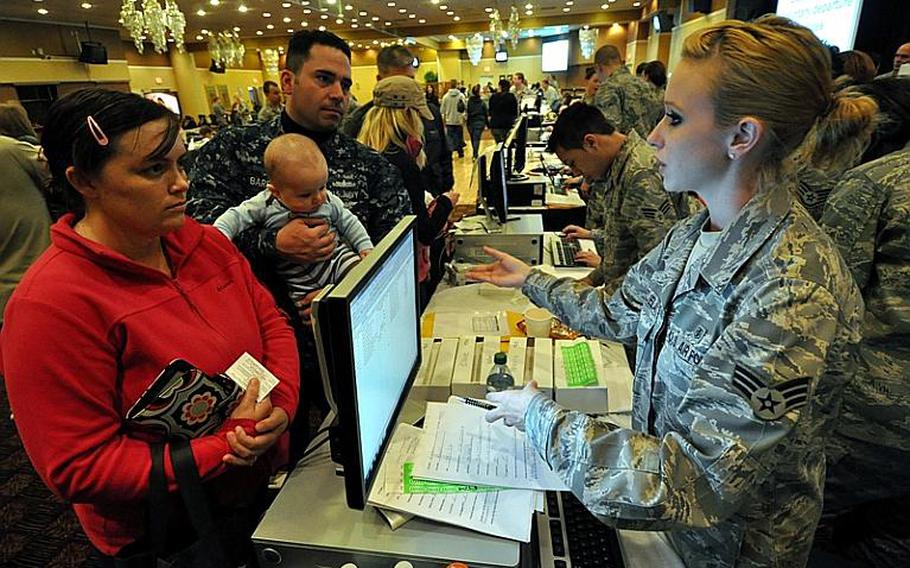
Petty Officer 1st Class Richard Barber, holding 6-month-old son Ronin, and Barber's wife, Rachel, listen as Senior Airman Shannon Valenzuela explains in March how they will be contacted when it's time for Barber's family to leave Misawa Air Base, Japan, under a voluntary departure program. (Stars and Stripes)
CAMP FOSTER, Okinawa — The Department of Defense paid nearly $35 million for U.S. military families who chose to flee Japan amid the Fukushima nuclear crisis earlier this year, according to figures obtained by Stars and Stripes.
As radiation leaked from the damaged power plant in March, about 9,720 dependents at bases in central and northern Japan took the military up on its offer of a voluntary evacuation, flying to the United States and a handful of other countries where their lodging and daily expenses were later reimbursed by the government.
The evacuation order lasted one month, but some families chose to stay in the U.S. longer to allow children to finish the school year where they had taken shelter.
The families’ daily living expenses alone cost the DOD more than $20 million and were mostly rung up in military cities such as San Diego and small towns throughout the country where evacuees sought refuge, the four services reported.
Airfare out of Japan, including military-chartered flights, added another $14 million to the total bill, according to U.S. Forces Japan and the DOD press office.
During the crisis, military commanders on the ground had repeatedly told families living on bases in Japan there was no significant radiation threat, but there was still a flood of frightened residents boarding flights out of the country after the DOD issued the voluntary evacuation order March 17.
USFJ spokesman Maj. Neal Fisher said the military will not second guess the evacuation.
“We made a decision based on what we had at the time,” Fisher said Tuesday. “We are always going to err on the side of safety, especially when it comes to servicemembers and their families.”
The voluntary evacuations included only military dependents and allowed servicemembers on duty at the time — some working within the disaster zone and in areas that might have exposed them to radiation from Fukushima — to have some peace of mind, he said.
“In order for those servicemembers to do their jobs … they needed to know with 100 percent certainty that their families were safe,” Fisher said. “Would we have done anything differently? No, we wouldn’t have.”
The Navy paid the most for families to flee Japan — $14.4 million was reimbursed to those who filed travel vouchers following the evacuation, according to the Navy Office of Information. The service has two bases within about 150 miles of the Fukushima plant, which include the headquarters of the U.S. 7th Fleet and the homeport of the USS George Washington aircraft carrier.
Air Force families who fled Yokota and Misawa air bases were reimbursed $4.8 million for travel, according to the Air Force Press Desk.
The Army has only a small population in central Japan and spent slightly more than $1 million on families seeking shelter abroad, Army Headquarters public affairs said. Meanwhile, the Marine Corps and the DOD school system in the Pacific said they paid hundreds of thousands of dollars on dependent evacuations.
Defense spending has come under intense scrutiny this year as the U.S. struggles with a lagging economy and deep debt. Military leaders have said the services must accept cuts and rein in the way money is spent. But fear quickly outpaced concerns over budgets in March when the Fukushima Dai-ichi nuclear power plant was critically damaged by a massive 9.0 magnitude earthquake and ensuing tsunamis.
Radioactive fallout from the damaged plant spread in a plume over northeastern Japan and was eventually picked up by sensors in the continental U.S.
The USFJ commander, Lt. Gen. Burton Field, later told Stars and Stripes the military was unsure how much radiation was being released and how far it might spread until after the voluntary evacuation order was called. Meanwhile, uncertainty and fear over the radiation threat swept across Yokosuka Naval Base, Misawa Air Base and other installations in the region. Despite some public claims that evacuees were essentially cashing in on DOD-paid vacations, many dependent mothers and fathers packed suitcases and loaded up children to flee.